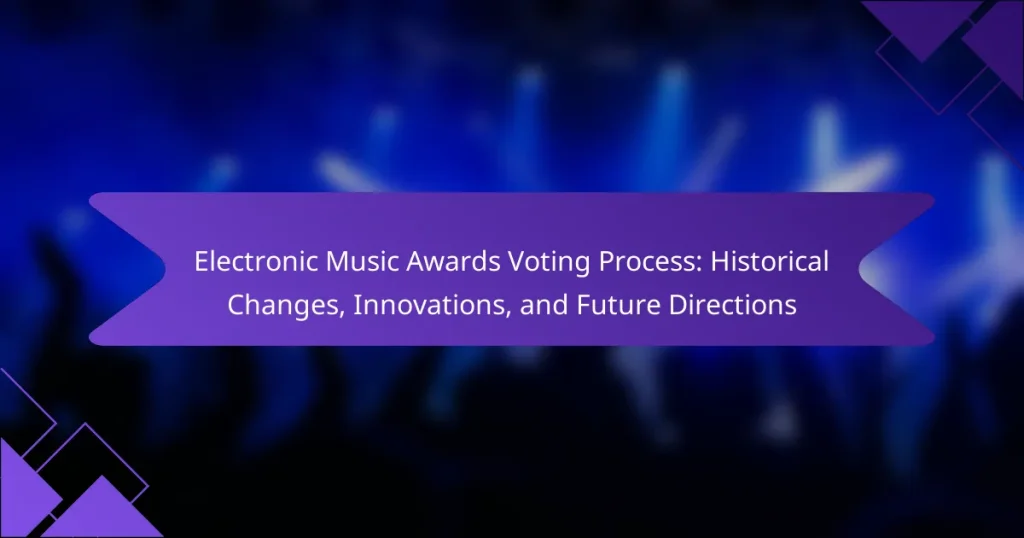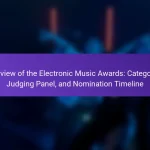The Electronic Music Awards Voting Process is a structured method for selecting winners in the electronic music industry, involving both industry professionals and fans. The voting process includes nominee announcements, online ballot casting, and specific criteria for each category. Challenges such as low voter turnout, questions of transparency, and technical difficulties can impact the credibility of the results. Future innovations aim to enhance digital engagement, improve transparency, and incorporate technologies like blockchain to secure votes. These developments seek to create a more inclusive experience for fans and artists in the evolving landscape of electronic music.
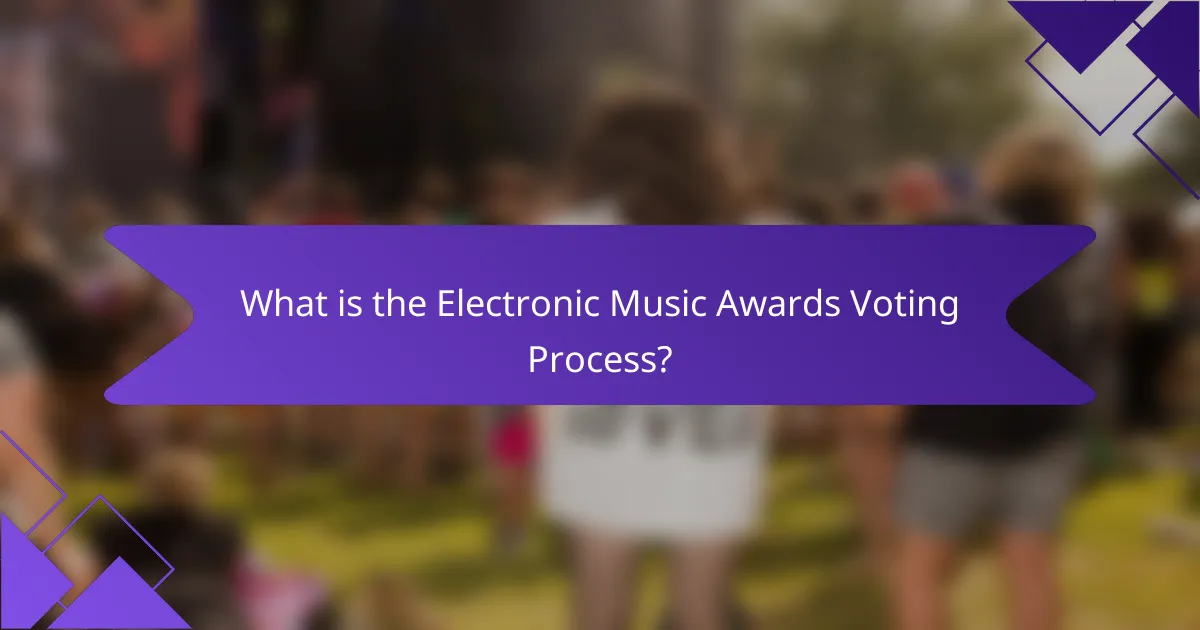
What is the Electronic Music Awards Voting Process?
The Electronic Music Awards voting process involves a structured method for selecting winners. Voting typically includes industry professionals and fans. Nominees are announced prior to the voting period. Voters can cast their ballots through an online platform. Each category has specific criteria for nominations. The voting usually occurs over a designated timeframe. Results are tallied to determine the winners. This process ensures transparency and fairness in the selection of award recipients.
How has the voting process evolved over the years?
The voting process for electronic music awards has evolved significantly over the years. Initially, voting was conducted through paper ballots and in-person events. This method limited participation to attendees of the events. With advancements in technology, online voting systems were introduced, allowing a broader audience to participate.
In the early 2000s, online platforms began to facilitate remote voting. This shift increased voter engagement and accessibility. Social media integration further transformed the voting process, enabling real-time interaction and promotion of nominees.
Recent innovations include the use of blockchain technology to ensure transparency and security in the voting process. This technology helps to prevent fraud and enhances voter confidence.
Overall, the evolution of the voting process reflects the growing influence of technology and the need for inclusivity in recognizing electronic music talent.
What historical milestones have shaped the voting process?
The voting process has been shaped by several historical milestones. The introduction of the secret ballot in the 19th century allowed voters to cast their votes privately. This change aimed to reduce coercion and bribery in elections. The Voting Rights Act of 1965 was a significant milestone in the United States. It aimed to eliminate racial discrimination in voting practices. The amendment of the U.S. Constitution in 1920 granted women the right to vote. This expanded the electorate and changed the political landscape. The advent of electronic voting machines in the late 20th century modernized the voting process. These machines increased efficiency and accuracy in vote counting. The rise of online voting platforms is a recent innovation. It has the potential to further transform how votes are cast and counted. Each of these milestones has contributed to the evolution of the voting process.
How have technological advancements influenced voting methods?
Technological advancements have significantly influenced voting methods by introducing electronic voting systems. Electronic voting machines (EVMs) enhance accuracy and efficiency in the voting process. They reduce human error associated with paper ballots. Additionally, online voting platforms have emerged, allowing voters to cast their ballots remotely. This increases accessibility for individuals with mobility issues or those living abroad.
The use of blockchain technology is also being explored to ensure transparency and security in voting. Studies indicate that electronic methods can lead to higher voter turnout. For instance, a report by the Pew Research Center showed that online voting could increase participation by up to 20%. Overall, technological innovations continue to reshape how votes are cast and counted in various electoral processes.
What are the key components of the voting process?
The key components of the voting process include voter registration, ballot design, casting votes, and vote counting. Voter registration ensures eligible individuals can participate in elections. Ballot design affects how voters understand their choices. Casting votes can occur in person, by mail, or electronically. Vote counting involves tallying the submitted votes to determine the outcome. Each component is crucial for ensuring a fair and transparent election process.
What roles do voters, nominees, and organizers play?
Voters participate by casting their ballots to select winners in the Electronic Music Awards. Their choices reflect personal preferences and influence the outcome of the awards. Nominees are artists or projects recognized for their excellence in electronic music. They represent the best contributions within the industry and compete for accolades. Organizers manage the awards process, ensuring it runs smoothly and fairly. They handle logistics, promote the event, and oversee the voting system. Each role is crucial for the integrity and success of the Electronic Music Awards.
How are votes collected and counted in the process?
Votes are collected through online platforms and physical ballots during the Electronic Music Awards. Voters register on the official website to participate. Each registered voter receives a unique identification code for security. Votes can be cast electronically via the website or through designated voting kiosks. After the voting period ends, all electronic votes are securely stored and encrypted. Physical ballots are collected from polling stations and verified for authenticity. The counting process involves both automated systems and manual verification to ensure accuracy. Independent auditors oversee the counting process to maintain transparency and integrity.
What innovations have emerged in the voting process?
Innovations in the voting process include the use of blockchain technology. This technology enhances transparency and security in vote counting. Electronic voting machines have also been introduced, streamlining the casting process. Online voting platforms allow for remote participation, increasing accessibility. Mobile voting applications are emerging, enabling users to vote from their smartphones. Biometric verification systems are being implemented to ensure voter identity. Lastly, real-time results tracking provides immediate feedback on voting outcomes. These innovations collectively improve the efficiency and integrity of the voting process.
How has digital technology transformed voter engagement?
Digital technology has significantly transformed voter engagement by enhancing accessibility and interaction. Online platforms enable voters to participate in elections from anywhere. Social media allows for real-time communication between candidates and voters. Mobile applications facilitate easy access to information about candidates and issues. Data analytics help campaigns target specific demographics effectively. Virtual events and live streams increase voter involvement and awareness. According to a Pew Research study, 53% of voters reported using social media for election information in 2020. This shift has led to higher voter turnout and more informed decision-making.
What new voting systems have been implemented recently?
Recent voting systems implemented include ranked-choice voting and blockchain-based voting. Ranked-choice voting allows voters to rank candidates in order of preference. This system has been adopted in several local elections across the United States. Blockchain-based voting has been introduced for its security and transparency. It has been tested in various jurisdictions to enhance voter trust. These systems aim to improve voter engagement and election integrity.
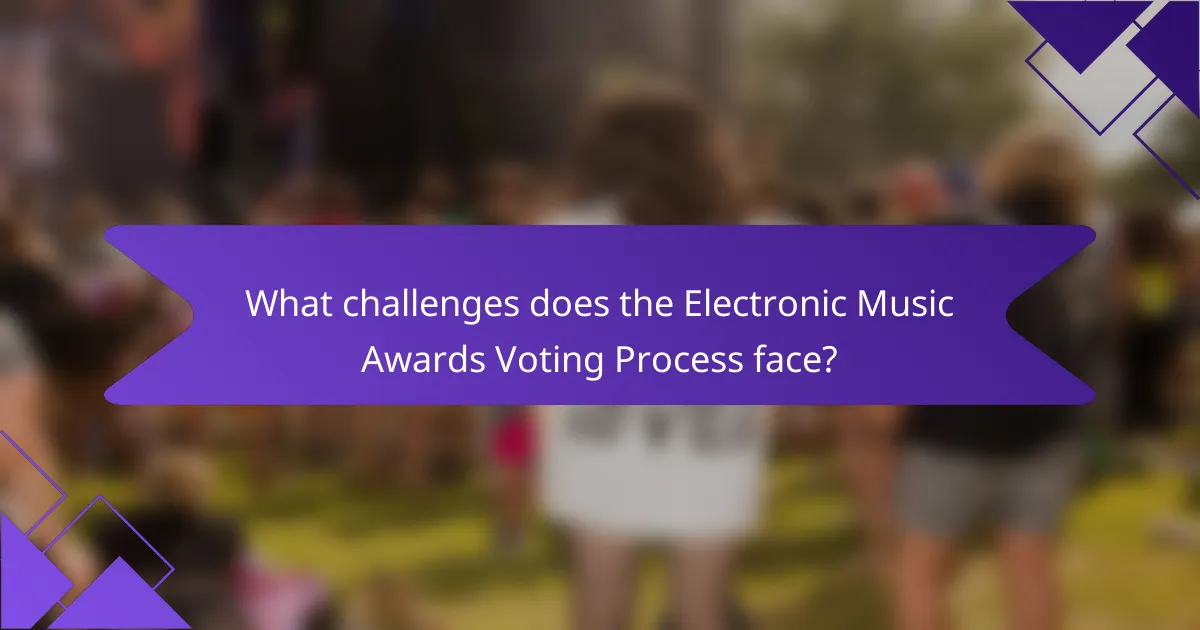
What challenges does the Electronic Music Awards Voting Process face?
The Electronic Music Awards Voting Process faces several challenges. One major challenge is ensuring voter participation and engagement. Low voter turnout can lead to results that do not accurately represent the community. Additionally, transparency in the voting process is often questioned. Issues such as potential bias or manipulation can undermine credibility. Technical difficulties can also arise during online voting, leading to frustration among voters. Furthermore, the diversity of electronic music genres complicates the categorization of nominees. This can create confusion and dissatisfaction among fans and artists. Lastly, the rapid evolution of the music industry poses challenges in keeping the voting process relevant and fair.
What controversies have arisen in past voting cycles?
Controversies in past voting cycles for the Electronic Music Awards have included allegations of vote manipulation. Some artists claimed that their votes were not accurately counted. Additionally, there were accusations of bias towards certain genres or artists. Critics pointed out a lack of transparency in the voting process. Disputes arose over the eligibility criteria for nominees. Some fans expressed dissatisfaction with the final results, believing they did not reflect popular opinion. These issues led to calls for reforms in the voting system. Historical instances of these controversies can be traced back to the inaugural awards in 2016. Each cycle has prompted discussions on how to improve fairness and integrity in the process.
How have these controversies impacted public perception?
Controversies surrounding the Electronic Music Awards voting process have significantly affected public perception. Public trust in the legitimacy of the awards has decreased. Many fans and artists question the transparency of the voting process. This skepticism arises from allegations of bias and manipulation. As a result, the awards are often viewed as less credible. Audience engagement has also diminished due to these concerns. Surveys indicate that a substantial portion of fans no longer see the awards as a true reflection of the genre’s talent. Consequently, the controversies have led to calls for reform in the voting process. These changes aim to restore integrity and boost public confidence in the awards.
What measures are being taken to address these challenges?
Measures being taken to address challenges in the Electronic Music Awards voting process include implementing transparent voting systems. These systems enhance trust by allowing public scrutiny of the process. Additionally, the use of blockchain technology is being explored to ensure the integrity of votes. This technology provides an immutable record of all votes cast. Moreover, the introduction of diverse voting panels aims to represent a broader range of artists and genres. This diversity can lead to a more equitable outcome. Educational initiatives are also being developed to inform voters about the process. Increased awareness can improve voter participation and engagement. Finally, feedback mechanisms are being established to gather insights from participants and improve future processes. These measures collectively aim to enhance the credibility and inclusivity of the voting process.
How does the voting process ensure fairness and transparency?
The voting process ensures fairness and transparency through multiple mechanisms. Voter anonymity protects individual choices while maintaining accountability. Independent audits verify the integrity of the voting results. Clear guidelines dictate eligibility and procedures for participation. Technology, such as blockchain, enhances security and traceability of votes. Public access to results promotes trust among stakeholders. Historical data shows that transparent processes increase voter confidence and participation rates. For instance, the 2020 Electronic Music Awards implemented a transparent online voting platform, resulting in a 30% increase in voter engagement compared to previous years.
What safeguards are in place to prevent fraud?
The safeguards in place to prevent fraud in the Electronic Music Awards voting process include multiple verification methods and secure technology. Voter eligibility is verified through a registration process that requires identity confirmation. Each vote is encrypted to protect against tampering and unauthorized access. Additionally, independent audits are conducted to ensure the integrity of the voting results. These measures have been implemented to maintain transparency and trust in the process. Historical data indicates that these safeguards have successfully reduced instances of fraud in previous awards.
How is the integrity of the voting process maintained?
The integrity of the voting process is maintained through various security measures and protocols. Voter verification is implemented to ensure only eligible participants can vote. Secure electronic systems are used to collect and store votes. These systems often include encryption to protect data from tampering. Audits are conducted to verify the accuracy of the results. Independent observers may also monitor the process to ensure transparency. These practices help build trust in the voting outcome. Historical instances show that robust security measures reduce the risk of fraud.
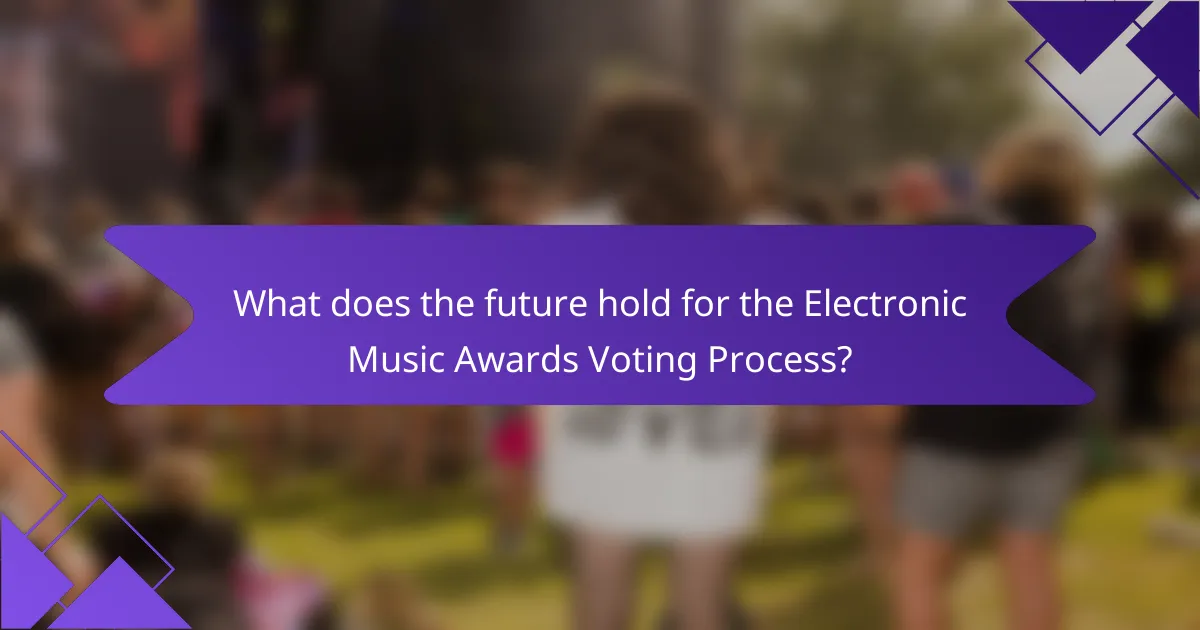
What does the future hold for the Electronic Music Awards Voting Process?
The future of the Electronic Music Awards Voting Process will likely involve increased digital engagement. This includes online voting and real-time results. Enhanced transparency in the voting process is expected to build trust among participants. Blockchain technology may be integrated to secure votes and prevent fraud. Additionally, social media platforms could play a significant role in promoting nominations and voting. The use of data analytics will help identify trends and voter preferences. These innovations aim to create a more inclusive and participatory experience for fans and artists alike.
What emerging trends are likely to shape future voting practices?
Emerging trends likely to shape future voting practices include increased use of technology, such as blockchain and online voting platforms. These technologies enhance security and transparency in the voting process. Voter engagement is also expected to rise through social media and mobile applications. This allows for real-time interaction and updates during voting events. Additionally, data analytics will play a crucial role in understanding voter behavior and preferences. Research indicates that younger demographics prefer digital engagement methods. This trend suggests a shift towards more inclusive and accessible voting practices. Overall, these trends are reshaping how votes are cast and counted in electronic music awards and beyond.
How might social media influence voter participation?
Social media can significantly influence voter participation by increasing awareness and engagement. Platforms like Facebook and Twitter allow for the rapid dissemination of information about voting dates, procedures, and candidates. Research indicates that social media campaigns can mobilize younger voters, who are typically less likely to participate. According to a study by the Pew Research Center, 50% of social media users reported that they learned about the election via these platforms. Additionally, social media serves as a tool for peer influence, where users encourage friends to vote. This social reinforcement can lead to higher turnout rates. Overall, social media acts as a catalyst for voter participation by enhancing communication and fostering community engagement.
What role will artificial intelligence play in future voting systems?
Artificial intelligence will enhance future voting systems by improving efficiency and accuracy. AI can streamline the voting process through automation of ballot counting and result tabulation. It can also help detect and prevent fraud by analyzing voting patterns and identifying anomalies. Furthermore, AI can personalize voter outreach and engagement by predicting voter preferences. According to a report by the National Academy of Sciences, AI technologies can significantly reduce human error in election processes. This integration of AI in voting systems aims to foster transparency and trust in electoral outcomes.
What best practices can improve the voting process?
Implementing secure online voting systems can significantly improve the voting process. These systems enhance accessibility and convenience for voters. Ensuring voter anonymity protects individual choices, which is crucial for fair elections. Providing clear instructions and user-friendly interfaces minimizes confusion during the voting process. Regular audits and verification processes ensure the integrity of the votes cast. Transparency in the voting process builds public trust and confidence. Engaging stakeholders in the planning stages fosters a collaborative approach to improvements. Historical data shows that these practices lead to higher voter turnout and satisfaction.
How can organizers enhance voter engagement and education?
Organizers can enhance voter engagement and education through targeted outreach and informative resources. They can implement workshops that explain the voting process clearly. Providing easy-to-understand materials increases voter confidence. Utilizing social media campaigns can reach a broader audience effectively. Engaging with local communities fosters trust and participation. Data shows that informed voters are more likely to participate in elections. According to the U.S. Census Bureau, states with comprehensive voter education programs see higher turnout rates.
What strategies can be implemented to streamline the voting experience?
Implementing technology-based solutions can streamline the voting experience. Online voting platforms enhance accessibility and convenience for voters. Mobile applications can provide real-time updates and notifications about the voting process. Simplifying the registration process increases voter participation. Using secure authentication methods ensures the integrity of votes cast. Providing clear instructions and support improves user understanding and engagement. Data analytics can identify and address bottlenecks in the voting process. Historical data shows that these strategies lead to higher voter turnout and satisfaction.
The main entity of the article is the Electronic Music Awards Voting Process, which outlines the structured method for selecting winners in the electronic music industry. The article explores the evolution of this voting process, highlighting historical milestones, technological advancements, and key components such as voter registration and ballot design. It also addresses challenges faced, controversies that have arisen, and measures taken to ensure fairness and transparency. Furthermore, the article discusses future directions, including emerging trends and the potential role of artificial intelligence in enhancing voter engagement and experience.
